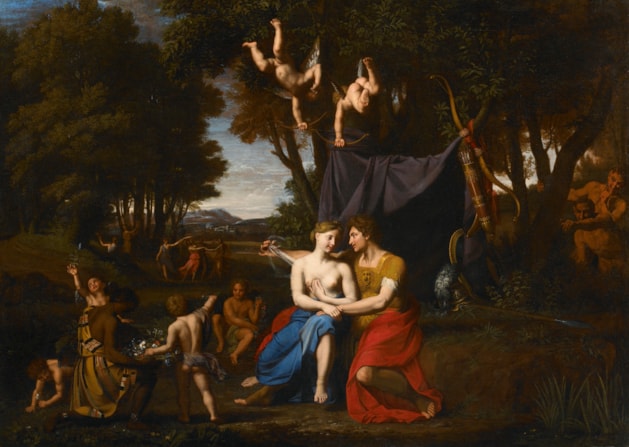Selection
COLOMBEL Nicolas
Mars and Venus
Oil on canvas121 x 170 cm
Executed circa 1690/1700 Provenance: Féréol Bonnemaison, 15, 16 and 17 July 1802, Paris(afterPoussin) « Mars et Vénus environnés de figures, tant Amours que jeunes filles et satyres dansant » ; Fabre sale , January 7th, 1813, Paris ; Daniel Besnard, 17-18 January1816, Paris, lot 403a Literature:: Will be included in the forthcoming catalogue raisonné of Nicolas Colombel by Karen Chastagnol.
Our painting is an important addition to the corpus of works known by Nicolas Colombel. The warmth of his tones and use of brighter colors than those used during his Parisian period allow us to date this work to the artist’s time in Italy (seemingly confirmed by the rather loose weave of the canvas), or to the first years after his return to France.
The Poussin influence so characteristic of his youthful work is still perceptible, particularly in the group of dancing bacchantes in the background. It was, however, waning, giving way to Bologna style and in particular, to that of Albani. While Colombel may have come into contact with his paintings in Italy, it should not be forgotten that numerous works by the artist entered into the French royal collections around 1685 (see L'Albane (1578-1660), Les Dossiers du Musée du Louvre, RMN, 2000).
This is the case in particular for the celebrated series devoted (as here) to the story of Venus, today in the collections of the Musée du Louvre (Inv. 9 to 12).
Adonis, being led to Venus by cupids, is an excellent illustration of how much Colombel owed to Albani, as much for his composition and palette, as for particular motifs, like that of the pirouetting cupids seen against the foliage.
While the treatment of faces, especially those of Mars and Venus, remains very similar to classic Italian models, Colombel attempts to introduce a degree of realism, perhaps influenced by the work of Scandinavian artists in the treatment of some secondary figures.
The presence of a black servant is an example—then rather rare among French artists—of the introduction of exotic elements into a painting.
Blending a degree of sensuality with an erudite knowledge of mythology, the theme of Mars and Venus was frequently taken up in the 17th and 18th centuries by French artists. Goddess of Beauty and Love, Venus was born of the union of Zeus and Dione.
Wife of Vulcan, she is credited with many love affairs, one of the most famous with Mars, god of War. The son of Jupiter and Juno, the latter is represented with the attributes of the warrior: helmet, shield and lance, as well as a bow and quiver treated with refinement and great care given to detail. The two satyrs hidden in the copse seeming to be making fun of Mars and Venus, are an allusion to the mockery they were subjected to when Vulcan, knowing that he had been cuckolded, trapped them in a net while they were sleeping and made them an object of ridicule before the gods of Olympus.




